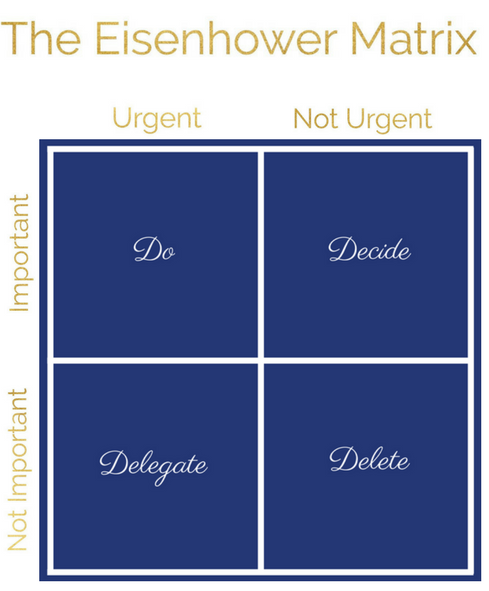On this blog, so far, I have focused on organizing stuff and spaces. I’m going to take a turn (and get real nerdy) with this post and concentrate on organizing time. In particular, setting priorities for our time. Do you currently have a goal (big or small) that you are trying to chip away at, yet feel like you can never make traction on, because ‘life’ gets in the way? On a smaller scale, do you ever start the week off with the intention of completing an important task or project, only to find that days have passed, and you’ve only scratched the surface (or done nothing at all) of what you needed to do even though you were constantly busy? Well, maybe you should try implementing the Eisenhower Principle to help prioritize your tasks. Yes, THAT Eisenhower…your favorite former US President and Army General and mine (at least he will be after learning his prioritization technique). Note: It’s also been popularized by Stephen Covey in his book “The 7 Habits of Highly Effective People” but Eisenhower did come first.

The Eisenhower Principle isn’t rocket science. In fact, it’s actually quite simple (as are all good frameworks). It centers around the concepts of urgency and importance:
Urgent activities are time sensitive items that require attention right away. Some examples include answering your ringing phone, completing tasks with an impending deadline, or watching Instagram stories before they disappear forever.
Important activities lead us toward our ultimate goals (personally or professionally) but don’t typically have deadlines associated with them. They often require planning, organization, and initiative. Some examples include writing a book, getting healthy, or starting a side hustle.

Using the Eisenhower Matrix, tasks are assigned to one of four boxes:
Box I: Important and Urgent -> Do Activity Now
Box II: Important but Not Urgent -> Decide When to Do the Activity
Box III: Not Important but Urgent -> Delegate the Activity
Box IV: Not Important and Not Urgent -> Delete the Activity
The theory behind Eisenhower’s Principle is that activities should be processed in order from I to IV. This ensures we are moving forward on our important tasks (aka our goals) without getting sidetracked by all those urgent tasks that pop-up every day. I think it’s obvious that items in Box I should be tackled first and often the urgency associated with them make it easy for these to be a priority.
Prioritizing items in Box II over Box III is where I think the difficulty comes in. Most people, myself included, can get caught up in tackling items in Box III first. The time component associated with urgent tasks makes them seem important. In addition, these activities are often quick to complete and there is just something psychologically fulfilling in checking an item off a to-do list (even if the item was never important to begin with).
In contrast, many of the items within Box II are ‘big’ tasks. Tasks that take concentration, and thought, and time. The matrix states that these tasks should be scheduled. I’ve found the best way to handle this is to take some time alone to really think about your goals, aka your important tasks, and break them down into mini tasks that are manageable daily. When I started this blog, I didn’t write ‘start a blog’ on my daily to-do list. If I did, it would have remained on my to-do list for who knows how long. Instead, I broke down the goal into a whole list of steps (that were constantly updated as I went through the process) and tackled at least one of them a day. This ensured that I was making progress on my important tasks daily instead of letting life’s fires get in the way.
I don’t think I need to mention much about Box III. These are the items you probably most successfully complete even though they are essentially distractions with a timeline (often imposed by others or self-imposed). The matrix states you should delegate these items. Now, I’m sure that was easy for dear Dwight given his position and if you have the means to delegate others to pick up your dry cleaning before the shop closes, or answer your emails, then that’s amazing and go for it! If not, I recommend trying to set up systems to eliminate these tasks all together (like selecting a dry cleaner with drop-off service) or minimize their impact (turn off your email notifications on your phone and computer and designate certain times of the day for email).
Last is Box IV. The matrix says these tasks should essentially be eliminated from our priority list. Now, if you have complete free time in your day, and are successfully making progress on your important tasks (only you can make that decision) then feel free to dabble in Box IV. Watch those House Wives, mindlessly scroll Instagram, and play those games on your phone. Sometimes we all need that downtime. Just don’t let these activities take up so much of your time that you don’t tackle those Box I and II activities.
I hope you find some time this week to establish your priorities based on the Eisenhower Principle and find it to be a valuable tool. If you do, I’d love to hear about it in the comments.
As always, I hope you found this post interesting, informative, inspiring, or entertaining (I’ll take any one as a success). If so, please let me know in the comments section. Also let me know if there is anything you’d like to see on this blog by writing me at feedback@theorganizingblonde.com.
XOXO,
The Organizing Blonde



Leave A Comment